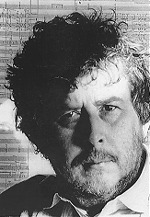|
|
Harrison Birtwistle
Gavin Thomas introduces the work of Harrison Birtwistle (1934–).
Overview
The raw and visceral music of Harrison Birtwistle often sounds as if it has
sprung into being from a point before or beyond the modern world, evoking
elemental human or natural forces, whether the stylized violence of Greek tragedy,
the elemental cycles of the natural world or the destructive march of time itself.
Many of Birtwistle’s earlier compositions possess the massive,
rough-hewn quality of a prehistoric monument, though as his career
has progressed he has also shown an increasing ability to produce music
of spare lyrical beauty and, on occasion, haunting delicacy.
During the 1950s, English music was dominated by the homespun
pastoral aesthetic of Vaughan Williams and his followers – a claustrophobic environment in
which the so-called “Manchester School”, a group of students at the Royal
Manchester College of Music consisting of composers Birtwistle, Maxwell
Davies and Alexander Goehr, plus conductor Elgar Howarth and pianist John
Ogdon, began their careers, looking to the latest developments
on the continent for inspiration.
Birtwistle bided his time, studying clarinet and keeping his ambitions as
a composer to himself until the premiere in 1959 o
f his wind quintet Refrains and Choruses, a work whose a
cerbic sonorities immediately announced the arrival of a strikingly individual voice.
For all the assurance of this and subsequent works, however, Birtwistle had
to wait until 1965 to score his first major critical success with
the ensemble piece Tragśdia.
The violent musical imagery of the work – choruses of s
hrieking woodwind and madly plucked harp alternating with hushed interludes
of intense but muted lyricism – perhaps owes something to
the example of Greek tragedy, an influence which also gave the work its
title (meaning “goat dance”) and which was to exert a lasting fascination on Birtwistle.
Birtwistle’s works of the 1960s culminated in the notorious chamber opera Punch and
Judy, premiered at the Aldeburgh Festival in 1968, an
event which caused even the normally undemonstrative Benjamin Britten – guiding
light of the festival – to walk out in protest.
What’s remarkable about the piece is not only its
unbridled savagery and weird subject matter, but also the way in
which, through a process of stylized re-enactment (Punch murders
the unfortunate Judy no fewer than four times), the
tragi-comic actions of a homicidal puppet are raised almost to the
status of myth – creating, as in instrumental works like
Tragoedia, a tension between the heated subject matter and
its ritualized presentation.
The work that really signalled the arrival of Birtwistle as one
of the major composers of his generation was The Triumph of Time
(1972), a monumental orchestral procession inspired by Brueghel’s depiction of the
remorseless progress of Time and Death.
The snatches of doleful
cor anglais melody which memorably punctuate the work exemplify the vein of plangent
lyricism with was increasingly to temper and enrich Birtwistle’s style.
Other works of the period, such as Meridian, The Fields of Sorrow and Melencolia 1,
gave evidence of Birtwistle’s new musical mastery, in which the harsh
Mediterranean landscapes of his Greek-inspired music are transformed into
something more muted and sombre, perhaps unconsciously suggesting the
depopulated rural expanses of Birtwistle’s native northern England – an
unexpected reinvention of the pastoral idiom (though with very different
musical effects) against which the members of the Manchester School had
so determinedly fought.
In 1986 came the long-awaited premiere of Birtwistle’s second opera,
The Mask of Orpheus, which, with its mythologized, masked characters, represents
the summation of his love of hieratic structures and repetitive narratives.
Since then, Birtwistle has increasingly turned his attention to opera.
In 1988 came the “mechanical pastoral” Yan tan tethera, a supernatural tale
of two shepherds, their sheep and the devil – of all Birtwistle’s operas,
perhaps the one that is most completely successful on both musical and dramatic levels.
Pastoralism of a rather different kind followed in 1991 with the monumental opera Gawain, whose bleak narrative counterpoints the Arthurian hero’s trials against the remorseless cycles of the seasons. Two further operas have been premiered since, each breaking surprising new ground. The characters of The Second Mrs Kong (1994) include not only Orpheus and Eurydice, but also Vermeer, King Kong and a beauty queen, while The Last Supper (2000) is based around the idea of a reuinion between Jesus and his disciples two thousand years after the event.
Despite this commitment to opera, Birtwistle’s increasingly prolific
output has continued to include many purely instrumental work, such as the
masterful Secret Theatre (1985), the massive Earth Dances (1986) for orchestra,
and a sequence of “concertos” (the label is barely adequate) for trumpet
(Endless Parade, 1987), piano (Antiphonies, 1993), tuba (The Cry of Anubis, 1994)
and saxophone (Panic, 1995) – works in which the savagery of
earlier pieces seethes, volcanically, beneath an often richly
poignant lyricism.
Despite
the relatively greater user-friendliness of his recent music, however,
the ten thousand outraged listeners who jammed the BBC switchboards after the premiere of Panic at the Last Night of the Proms in 1995 testify to the fact that, thankfully, Birtwistle has lost none of his power to shock and surprise.
Article and review pages originally published in The Rough Guide
to Classical Music
|